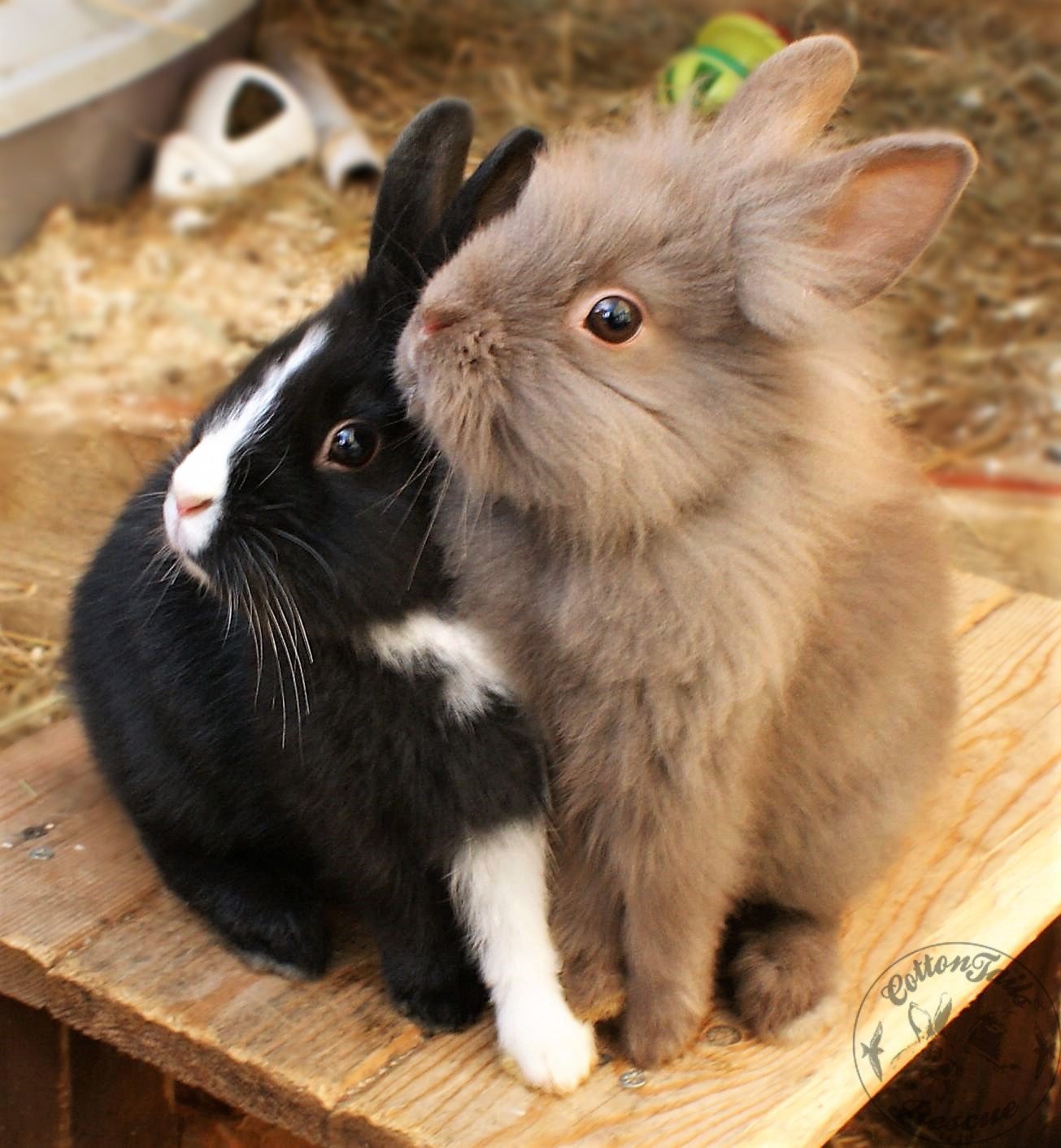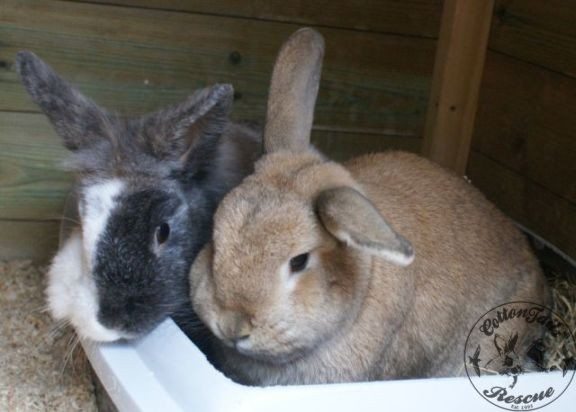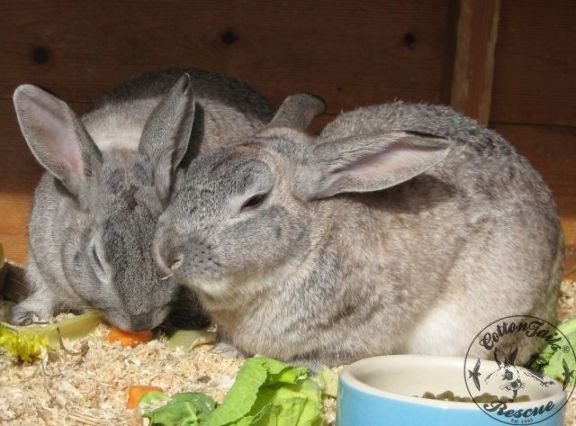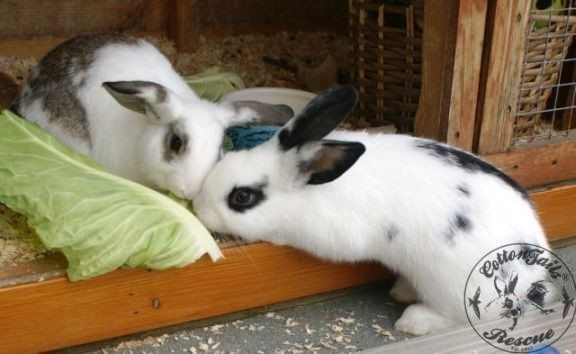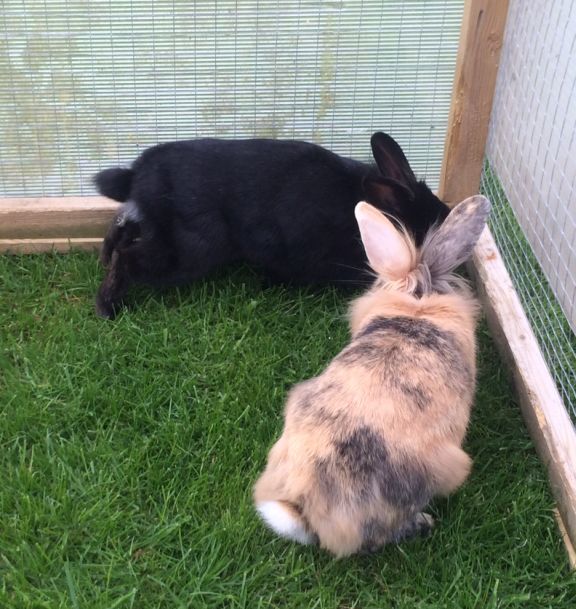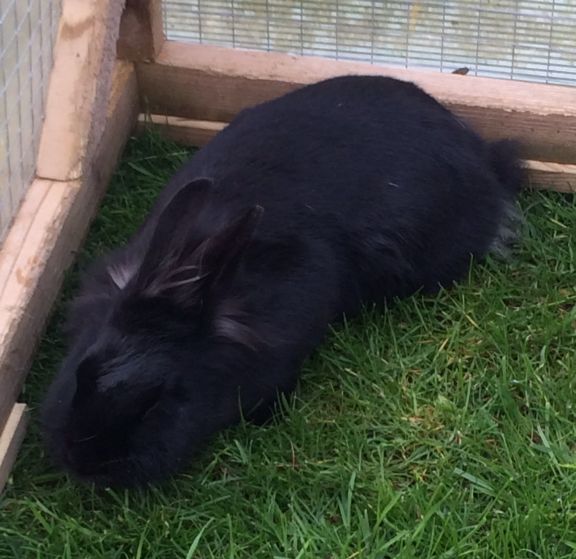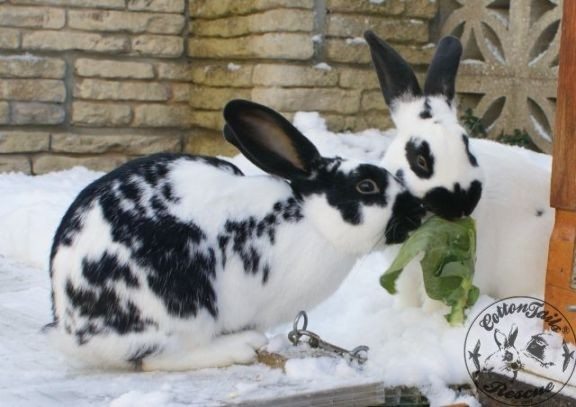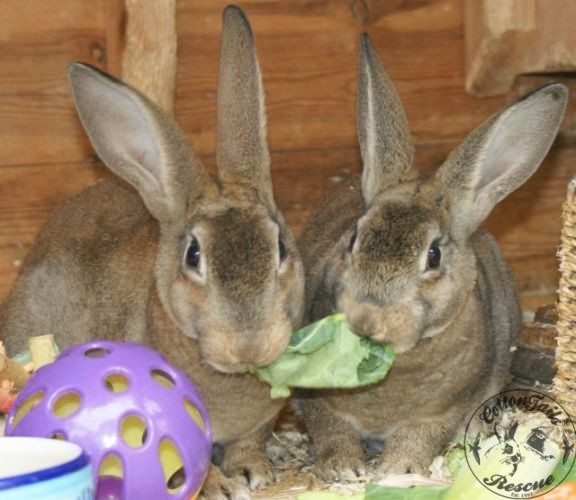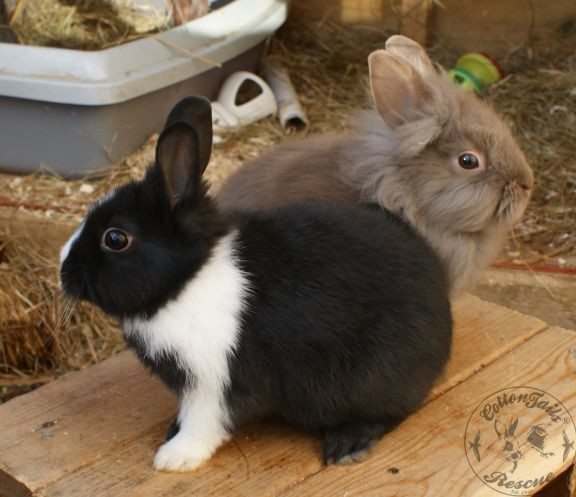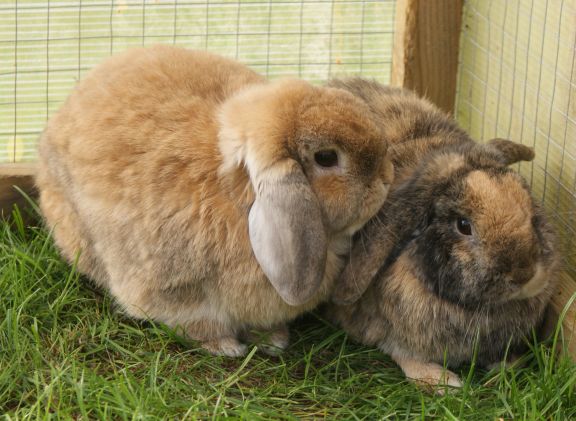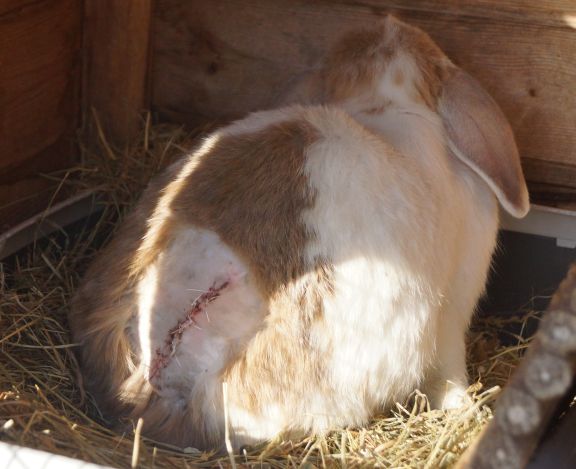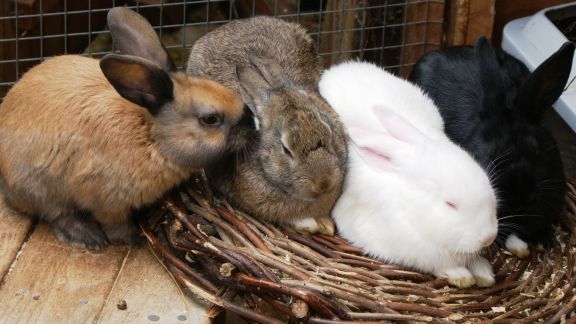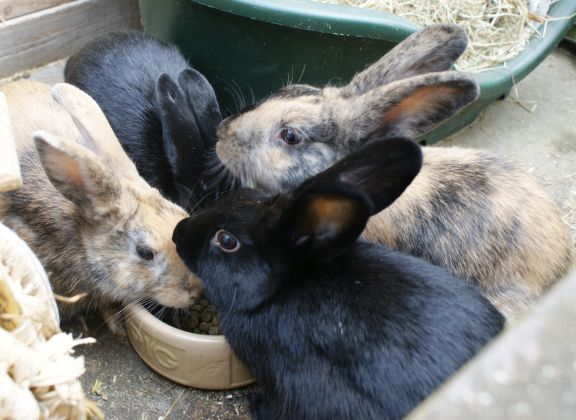Why Should You Consider Bonding Your Rabbit?
Most rabbits are territorial by nature. However, this does not mean they all must lead solitary lives. Rabbits living in compatible pairs or occasionally even small groups will often benefit in many ways, including companionship, mental and physical stimulation, and a grooming partner!
Once you see how happy rabbits are when living in bonded pairs, you will vow never to keep a rabbit on its own again if at all possible. Although there are exceptions to any rule, many rabbits can be successfully matched so long as care is taken when choosing a suitable partner. As the process can take several weeks or months, some thought must be given to their environment. Most of our rabbits at CottonTails® rabbit and guinea pig rescue are re-homed in pairs. Still, there is a significant minority who will not accept another rabbit, no matter how well the introductions are carried out.
I have found from personal experience that rabbits who are very “humanised” (such as house bunnies that are extremely comfortable around their human friends) can be amongst the most challenging to bond, with such attempts often failing. Elderly rabbits that have lost a partner can often fail to accept a new friend, too, and in many cases, they ironically appear happier and content once they have accepted that their lost friend is not coming back. With this in mind, it is wise to always wait at least 2-3 weeks after the loss of a rabbit before rushing into re-bond, both from the possible disease transmission risk and to see if the rabbit will settle down and appear happy and content.
Although the general thrust of this article is about bonding your rabbit, please do not feel pressured into trying to match up your rabbit just because you think this is something you have to do. Whilst most rabbits do benefit from living with a compatible other, there is a sizeable minority that does seem to prefer to live without having to share their environment, especially if they are humanised and have a lot of attention from their owner. This can be especially true of house rabbits and elderly rabbits who sometimes prefer to be on their own despite having shared their life until recently with a bunny partner.
I received this message from a bunny owner who was trying to achieve harmony between her pets:
“Thank you so much for posting these bunny bonding videos. I’ve been trying to bond a trio of buns for a while, but I’m not confident in what I’m doing so it’s been stop and start. The only help I’ve had is reading /watching videos on the internet or talking to my vet, and nothing has shown me what bad bunny behaviour looks like. You read about it , but don’t get to see it. I really appreciated seeing everything as it unfolded in the videos of Bella and Rusty and Bella and Major. Your videos have given me inspiration to try again.
Thank you!”
Whilst no doubt keeping rabbits in compatible pairs works best from the compatibility point of view, there are some (but not many) circumstances where a group or trio may work, so for more information on that topic, click on the sidebar link for “Groups and Trios” or scroll down to the foot of this article.
The film below shows how a single bunny can be very happy if given appropriate stimulation and activities:
If your rabbit has been recently bereaved, it is best to wait a couple of weeks or so and observe their behaviour to determine whether they are missing the companionship – this can be seen by noting changes in behaviour where a rabbit is perhaps more reserved, less outgoing, and seems to spend a lot of time hunched and inactive (not to be confused with the onset of gut stasis). Sometimes, you will see this behaviour, but some rabbits regain their bounce within a week and gain a new lease of life. So, the point I am making here is to take each rabbit as an individual and decide what to do based on the circumstances involved, not on what someone says in a book or website.
Neutering of both partners is vital for long-term success, and ideally, this should be carried out before matching or, in the case of baby rabbits, as soon as they mature. With males, this is usually between 10-16 weeks of age (as soon as the testicles descend), and females are spayed from 16 weeks onwards so long as they weigh over 1kg. My observations have shown that young rabbits recover just as fast, if not quicker, than adults, and waiting until the rabbits are 5-6 months old can cause many problems, including fighting or breeding. Before looking at possible pairing combinations, some general points should be considered when matching rabbits.
There are two main methods of bonding rabbits, the fast-track system and the slow approach, and although the fast-track method is examined first, it is NOT my preferred method unless time or space restrict following the preferred slower approach. The fast track method is not ideal, as the sudden introduction of two rabbits that have never met can lead to unnecessary fighting and injuries. I favour combining the two approaches, starting with the slow bonding method and then swapping to the fast track system after 2-4 weeks.
Fast Track System
With the fast-track system (or after the initial side-by-side living of the slow bonding method), neutral territory is usually necessary for the initial encounter and the first few days after that until the rabbits have accepted each other. This is somewhere where neither rabbit has been before, but it must be large enough to allow plenty of room for them to get away from each other if necessary. This could be a shed, a garage, a greenhouse, or anywhere they will be safe to live together until they have bonded. This usually takes about a week, by which time they should enjoy each other’s company by grooming each other and choosing to sit together. During this time, they should be provided with distractions such as cardboard boxes (also useful to hide in) and their usual food, hay and water.
If you want to follow the fast-track method, please take your rabbit with you when choosing a new partner for them so that they can meet in neutral territory initially and then travel back together in the same carrying box (see below for details of this initial encounter). Travelling together is a proven method of kick-starting the bonding process, as both rabbits are afraid during the journey home and look to each other for support and comfort. An extra box can be taken just in case the two have to be separated on the route, but this is extremely rare as once the journey starts, the rabbits usually sit very still and quiet. However, there is no need to take the other rabbit with you if following the slow bonding method, as they will be living side by side for at least a couple of weeks before they meet face to face.
Don’t forget to find out what food your new rabbit has been fed so you can make any diet changes very gradually, and also find out if the new rabbit is used to a water bowl or bottle, as rabbits that are used to a bowl will not be able to use a bottle successfully.
The Initial Encounter
This should occur on territory unknown by either rabbit, using an existing territory only if that particular individual is highly nervous and submissive towards other rabbits. You usually get an excellent indication of whether or not the new combination has a chance of working within the first 15 minutes. However, it is normal for both rabbits to ignore each other for a while.
Common initial behaviours include mounting by one or both parties, often at the wrong end and sometimes both rabbits trying to mount each other simultaneously, resulting in them spinning round and round in circles with ever-increasing speed.
A small amount of aggression is expected at the start as they try to establish the hierarchy in the relationship. Sometimes, a rabbit may appear too afraid to move and refuse to come out of the corner, but this is common and usually resolves itself with time. This is a small price to pay if the result is the formation of a strong friendship that could last for the rest of their lives. The benefits of company are apparent and far outweigh any minor short-term problems, so don’t panic straight away, be patient and observant and be prepared to “let them get on with it” so long as it doesn’t become serious.forever-loving
Sometimes, you will find that either the male or the female will show very submissive behaviour and appear to opt out of the proceedings by going completely flat. This is nothing to worry about, and usually, they will get up and move around or preen themselves once they feel the onslaught of mounting or other unwanted attention has ceased.
Aggression
Very occasionally, one or both rabbits show severe aggression by attacking and wounding the other on the face or genital area or repeatedly on the body. These are severe attacks, and the encounter must be stopped immediately, as it is unlikely to work in the long term. Be careful when separating battling bunnies – you may get bitten in the confusion! In such situations, it does not necessarily mean that the rabbits have to live on their own permanently. It is more likely that that pair is incompatible for whatever reason, and different partners should be tried.
I remember one specific male who intensely disliked the first five females he was offered but adored the sixth! Below is a film by the rabbits’ owners of two previously forever-loving, strongly bonded brothers fighting. They were permanently separated after this film was taken, and thankfully, neither was seriously hurt.
The story of this trio can be found by following the link below:
Sometimes, a combination of the fast and slow bonding methods is helpful if one or both rabbits appear to be initially aggressive. While trying a different partner may make more sense, sometimes this is impossible, or the owner wants to persevere and try it. In such cases, having the rabbits living side by side with a partition between them for a couple of weeks can be helpful (for more details, see the “slow approach”). This partially desensitises the rabbits, so they are introduced a few weeks later. They already “know” each other, and their initial reaction to each other is not as emotional or animated as it would have been had they been introduced immediately.
The film below illustrates well the sound that some females make if persistently mounted by either a male or another female, and this should not be ignored if she continues to make this sound for more than a few days as it indicates she is distressed and anxious. It can be a common sound when bonding a neutered female with a neutered male (or female with female, but not a good idea – see below) and usually fades after a few days when the male’s interest reduces. In the case of the two sisters in the film, there was clearly an imbalance in the pairing, and shortly after the film was taken, they were separated and subsequently spayed and each matched with a suitable neutered male. The squeaky female did not make her sound again, not even with the bonding with the male, and was much happier.
Putting the squeaking rabbit problem aside, if the rabbits still have problems settling down after a week, take them for another ride in the car, ensuring they don’t overheat if travelling on a hot day. On your return, place them again in neutral territory; usually, you will find they are more willing to tolerate each other after this experience.
Possible behaviours to expect in initial match-up
Below is a quick guide to possible behaviours expected during the first few minutes of an initial match-up introduction:
- Both rabbits ignore each other. This is the most common behaviour pattern and usually lasts for the first few minutes of the introduction. However, interaction usually begins once the initial exploration of the accommodation is completed to their satisfaction.
- The male mounts the female. This is very common even with neutered rabbits and can trigger the female to either run away, try to mount the male, or stand her ground and fight.
- The female mounts the male, as point 2 but reversed.
- Tentative nose-to-nose contact, likely pulling away quickly initially and then repeating the behaviour a few minutes later.
- One rabbit becomes obsessed with the other through excessive grooming and other attentive behaviours; the other rabbit is very submissive and too afraid to move. This type of behaviour is not good news, as often, within days or weeks, the submissive partner “blows a fuse” eventually, and a massive fight ensues.
- One rabbit quickly dives at the other to give a quick nip but does not follow through and runs off.
- One rabbit launches a severe unprovoked attack on the other, biting under the tail or around the face and not letting up.
- Both rabbits start fighting within a minute of the introduction. This is quite rare but indicates little chance of the match working.
The Slow Approach – recommended bonding method
Another bonding approach is to house them in territories separated by a strong wire partition. If there is a fear that one rabbit may try to bite the other one through the partition, a double layer may be necessary to ensure a gap in between. This allows them to gradually get used to each other for several weeks before trying an actual face-to-face meeting. The disadvantage of this method is that it can take a long time, and there is no guarantee at the end that the rabbits will like each other, but it does reduce the chances of fighting and injuries. If you have one rabbit in a cage and the other running free, you must give each rabbit equal time in the two areas. Otherwise, the rabbit with the most freedom will consider himself “the winner” and develop an air of arrogance that can be difficult to undo!
The slow method can show incompatibility problems with the rabbits building up an increasing dislike of each other through the partition, seeing each other as a threat to their territory, and this means that if adequately introduced, they immediately fight as they feel they know each well enough to dispense with the formalities! If the two rabbits are not showing signs of attraction to each other or at least a tolerant indifference, the chances are high that it will not work, and it is best to call it a day at that point before even risking an actual introduction.
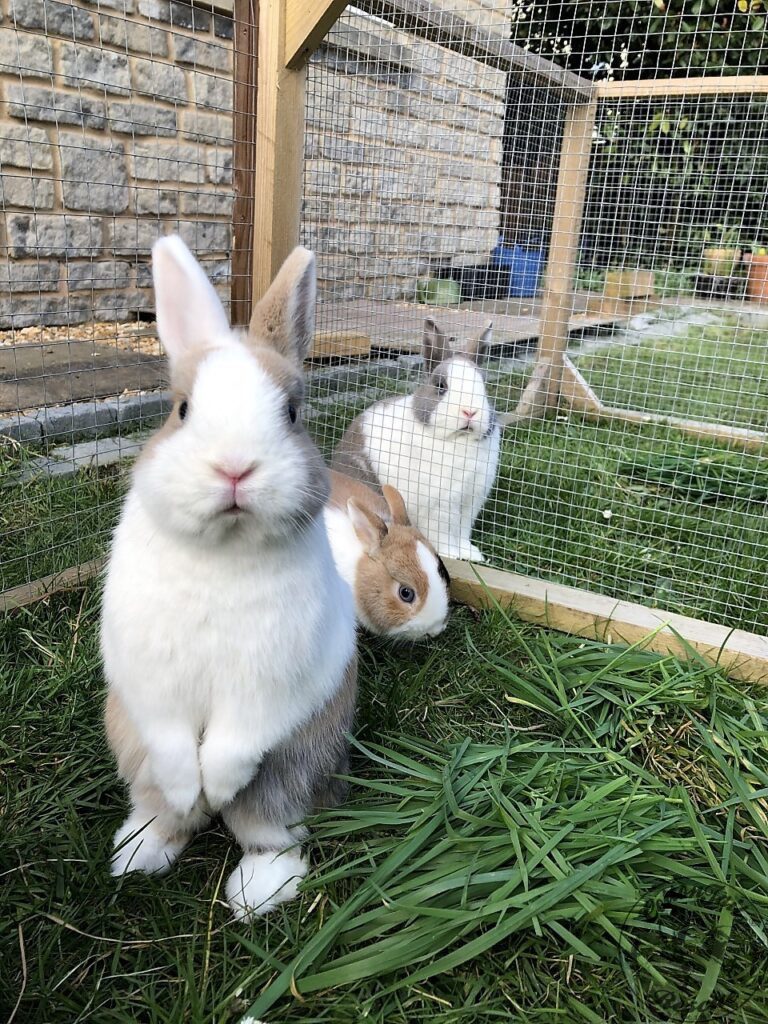
Surprisingly, it is not always a good idea to give a newly bonded pair of rabbits free run of a large garden too quickly, as this can lead to a territory dispute, and fighting can be the result, sometimes so severe that they must be permanently separated. This can sometimes happen even to a long-term bonded pair if they are re-homed and given lots of freedom within the first week or so of the move, mainly if they were not used to such space beforehand. It is best to wait 3-4 weeks to ensure they have settled down, allowing access to a run in the meantime.
Before reading any further, please take a few minutes to watch the following videos, as they all have interesting and important points to make, including one introduction that went horribly wrong!
You will be pleased to know that within hours of arriving in their new neutral territory, Buster and Bella were grooming each other side-by-side!
Their owners wrote the following:
Buster and Bella appear to be very comfortable together now. Most of the time, they sit or lie down together, side by side, nose to nose, head to tail. Bella seems to go towards Buster more than him to her. She often stretches herself out alongside him. They groom each other. This evening, we watched Buster groom her ears for quite a long time. Bella laps it up. We have seen no aggression between them since we brought them here. It is so heart-warming to see them being close and snuggling together.
Then, an update two weeks later: The two bunnies are like a single entity now. They spend much of their time in close contact. Bella seems very relaxed, often completely stretched out whilst leaning against Buster. There is a lot of ear grooming by both of them. We spend a lot of time watching them, telling each other what they have been up to and generally feeling amazed that they have become so close.
Mildred and Merlin’s match-up:
Rusty and Bella’s match-up did not work!
Bella and Major, a very difficult match:
Cherry and Peter’s bonding session did not go well:
Possible Combinations of Rabbit match-ups
Male with Female
Neutered male/neutered female pairings are the most successful long-term. Although compatible personalities are important, rabbits in such pairings are likely to show more tolerance towards each other than would necessarily be found in female/female or male/male match-ups. The large majority of opposite-sex encounters end very positively, with most males trying to do what comes naturally when presented with a new female companion.
Pairing a non-neutered female with a neutered male will sometimes work. Still, you are running the risk of the female’s hormone-driven mood swings (bunny “PMT”) seriously jeopardising their relationship long-term, as well as running the risk of her developing uterine and associated cancers at a later stage. It is also essential to know that males are fertile for up to 4 weeks after their castration operation. Therefore, mating during this time could result in pregnancy if the encounter is with an unneutered female.
Pairing a non-neutered male with a neutered female is only suitable in the rare event of the male not showing much sexual behaviour towards his partner. Males that repeatedly try to mount and/or spray the female long-term will often break the temper of their partner, and a severe fight will likely ensue. Also, it is unpleasant for owners to deal with a permanently sticky, smelly and yellow-tinged rabbit! The photo below illustrates one such rabbit, who should be pure white!
Occasionally, some long-term neutered males lose their sexual drive and can become aggressive towards any rabbit they meet. With this in mind, the bonding process may need to be taken at a slower pace to enable him to get used to the wire partition technique described above.
As a last resort in such situations, it may be worth trying to pair up “difficult” rabbits with a baby rabbit of the opposite sex. Still, close supervision is essential as a baby would be less able to defend itself if attacked. In most cases, the baby does not seem to be perceived as a territorial threat and, therefore, may be accepted by a domineering adult who otherwise would not allow any adult rabbit on its “patch”. When the baby comes of age, the pair should be well bonded, so no major problems should be encountered apart from minor behaviour adjustments. Neutering should be done as soon as possible to prevent the issues mentioned earlier. See “Bonded Pairs” below for advice on neutering a bonded pair.
Female with Female
Females will rarely live together long-term without neutering, as hormone-related behaviours cause friction between the pair, sufficient enough to cause severe fighting. Even if both females are neutered and have lived together from the start (such as sisters or mother/daughter combinations), it is not uncommon for them to fall out irreconcilably after months or even years have gone by, often for no apparent reason.
Possible Combinations – Male with Male
This combination usually only works if the two males concerned have been brought up together (true brothers work best) and have a good relationship at the time of their castration. The neutering operations must take place as soon as the testicles descend, usually at about 3-4 months of age, and they should both be castrated on the same day and immediately placed back together again in their normal environment on their return. If it is cold and they have not entirely recovered from the anaesthetic, both rabbits must be brought inside overnight, even if only one shows drowsiness.
Any fighting demonstrated before the operation will mean that the relationship is unlikely to succeed in the long term, and the rabbits should be separated before the castration operation and matched up with a neutered female instead. A word of caution: I have, on rare occasions, found from experience that two bonded males will sometimes start fighting even after a few years have passed, especially if moved to a new environment.
Don’t Ever Split Up A Bonded Pair
Once bonded, a pair of rabbits should not be separated unless necessary. Trips to the vet should involve taking both rabbits with you in the same carrying box, even if only one needs to be seen. If hospitalisation is necessary, however (such as for neutering), it may not be practical to leave both rabbits there, in which case, take the remaining rabbit with you when you collect their partner so they can travel back together for the journey home. However, if this would be detrimental to the recovery of the affected rabbit (e.g. having a wound or stitches in an accessible place), it may be necessary to separate them. This should be done for the shortest possible time as it may be difficult in some cases for the pair to accept each other again. In such situations, it may be necessary to “start from scratch” again using neutral territory or a wire partition until things settle down. In the case of neutering, ask the vet to use a technique that involves no external stitches to avoid problems associated with nibbling.
Rabbits usually recover much quicker in their usual environment with their partner. Therefore, if only one-half of a bonded pair is neutered and it is decided to neuter the other, there is usually no need to separate the pair after the operation unless the remaining rabbit causes distress due to harassment. An initial flurry of mounting activity is often encountered if the female has just been returned because her male partner will be pleased to see her. However, if this behaviour does not settle within a few minutes, remove the male for a few days until she is fit enough to cope with his advances.
If one of the bonded pairs has already been neutered and the other one then needs to be done, follow the guidelines below to make sure that the bond is not broken in the process:
- On the morning of the operation, take the pair to the vets (travelling together), and on your return home with the remaining bunny, put them somewhere different for the day if possible.
- When you collect the rabbit that has just been neutered, take the other rabbit with you so they can travel back home together.
- Unless the weather is extremely cold (such as in the middle of winter, in which case you may want to keep them both inside overnight), the pair should return to their normal environment again. You may find the male tries to mount briefly, but this is rarely a problem and soon settles down.
Fighting Between A Bonded Pair
Most match-ups work well in the long term, but occasionally, a bonded pair suddenly starts fighting for no apparent reason. In these circumstances, having both rabbits checked over by an experienced vet is advisable, as ill health in one or both can trigger this behaviour. I have seen several situations where one rabbit has been going through the onset of gut stasis, and the change in their behaviour has been enough to enrage the partner and stimulate aggression. Another example of this was with a recent spate of bullying between a strongly bonded pair that was proving a puzzle until I thoroughly examined both rabbits, only to find that very deep inside the male’s ear was the start of either an ear infection or mites.
Appropriate treatment was started immediately on both rabbits, and the aggressive chasing stopped immediately, indicating that the male was grumpy and unhappy due to his ear discomfort. Interestingly, after three weeks, he started to chase the female again, and on examination, I could see the problem was still lurking deep within one ear. Once treatment was underway, the bullying again stopped completely. It was lucky that the female was very submissive to the male, which prevented proper fighting from occurring, and the problem with a pair where the partner fights back is that they may fall out so significantly that even once the medical issue is resolved, they may have broken their bond for good.
Another bone of contention between an otherwise well-bonded pair is inequality of grooming, where only one rabbit is prepared to groom the other, despite desperate “pleas” by the other bunny to be groomed too. A trick to try is to put a few drops of yoghurt on the rabbit’s head that does all the grooming in the hope that the other reluctant partner will see this as a good idea and will lick off the offending droplets, grooming the bunny at the same time. Repeating this a few times can give the encouragement needed to demonstrate that mutual grooming is rather pleasant. Don’t put too much on; otherwise, you will stimulate the rabbit to self-groom, defeating the whole point! Most pairs of bunnies get better at sharing activities the longer they are together, but some retain their stubborn individuality for longer than others.
Factors That Can Trigger Fighting Between A Bonded Pair
Neutering
Whilst there will always be exceptions to any rule, it is rare for a pair of rabbits to stay happily together in the long term unless both are neutered. Some owners choose only to neuter the male in a male/female pair, but as time goes on, it is not uncommon for the unspayed female to have a false pregnancy. This, in turn, triggers territorial behaviour as she is convinced she is about to have a litter and may chase away any other rabbits in the immediate area, including her partner. The general rule is that for a bonding to work in the long term, both rabbits must be neutered, preferably before they are introduced to each other.
Gender of the pair
The gender (sex) of the two rabbits is really important. Generally, the best combination for bonding two rabbits for long-term success is a neutered male and a neutered female. Two males will usually only work in the long term if the males are brothers (having grown up together), are neutered early as soon as their testicles descend at around 12 weeks (or earlier depending on development), and at the point of neutering, they are not showing any signs of aggression towards each other – mounting is normal but aggressive chasing and fighting is not.
It is common for a pair of non-neutered males to start fighting from around three months onwards, but sometimes it can take 12-18 months before severe fighting arises, with serious and sometimes fatal consequences. Female pairs often fight later, sometimes taking 2-3 years before this happens, but it is so common that here at CottonTails®, we do not recommend bonding females with females even if both are spayed. This is true of sisters and mother/daughter combinations. However, if the females are over four, they will likely stay bonded as they have passed the main trigger stages and should be settled.
The initial bonding procedure
For rabbits that are bonded with another individual that is not known to them (i.e. not a litter mate or parent), the bonding method can be crucial. Common mistakes include not using neutral territory for the first week or two, and by neutral territory, I mean utterly unknown to both rabbits, where neither has seen or been in before. Cutting this initial stage short because the pair seem to be getting on well is another common mistake, as is giving a newly bonded pair too much room too quickly. Whilst the pair must have plenty of room to move around and get away from each other if necessary, giving them a whole garden to run around in shortly after being bonded asks for trouble. This often triggers fighting, and the only option is to go back a stage to the neutral territory again and, from there, gradually increase the area for exercise over a few weeks.
Accommodation
The size of the accommodation can also influence the behaviour of a pair of rabbits. It may seem obvious that shutting a pair of rabbits into a very small area could lead to frustration and fighting, but it is equally important not to give too much room too quickly, as outlined above. Some rabbits will not tolerate another rabbit around if they are in a very large space, which seems contradictory. Still, I have encountered several situations where a pair gets on well in a hutch with a run attached but fights severely when out in a large garden.
Health Issues
If one of the pair develops health issues, the relationship’s dynamics can drastically alter. An example of this would be in an older pair, where one rabbit develops arthritis and, as a result, is far more reluctant to move around. This can mean that the other rabbit feels neglected as their partner appears subdued and unresponsive, and sometimes even grooming between the pair is affected due to the one in discomfort failing to respond to the partner’s signals for attention. Some rabbits react in a very grumpy way to this change of behaviour, which can lead to significant fighting.
Thankfully, a daily dose of a pain medication such as Metacam can alleviate arthritis symptoms in many cases, allowing the affected rabbit to move around freely again. However, sometimes, if the bond is broken, it isn’t easy to mend. Even minor complaints can affect the relationship, particularly conditions like mites, as this can irritate the rabbit’s skin and make them uncomfortable and irritable.
Age
Some rabbits can change as they mature, so if a pair are bonded very young, there is sometimes a change in dynamics between the pair at the point of maturity, leading to a battle for dominance with often serious consequences. Sometimes, it will settle down again, but the damage is irreparable in some cases, and the pair have to be split up. The same can be true if an older rabbit is bonded with a much younger one, with a similar outcome.
Seasonal
Whilst there is no doubt that unneutered rabbits are affected by seasonal changes such as length of daylight and temperature, it may surprise some people that neutered rabbits are also affected similarly. Although neutered rabbits do not experience the variation of hormones compared to that of an intact rabbit, the pineal gland in the brain still reacts to environmental cues such as daylight changes in such a way as to instigate some behavioural traits that one would not expect in a neutered individual, including territorial behaviour in preparation for breeding. No surprises then when some bonded rabbit pairs suddenly start fighting in early spring.
This phase can last from a few days to 4 weeks or more, but in most cases, the pair settle down again to bonded bliss once more. However, the rift in some pairs can be so serious at this time that it permanently splits the bond between them, and this is especially the case where the bonding is not very strong anyway. It can be a problem for females, especially if they are not neutered. I have seen many bonded female pairs start fighting seriously around mid-February onwards when the length of daylight is significantly changing.
Changes
On the basis that a pair of rabbits has been matched correctly from the start, the most typical reason why a bonded pair fall out is that there has been at least one fundamental change that affects them directly. Examples of these are:
- New accommodation
- Much larger run
- New partner
- Significant weather change
- Sudden frightening noises or the frequent presence of a fox or other predator
- Addition of a new pet, such as a dog or cat
- Addition of another rabbit within visual or scenting distance
- A journey, especially if the pair do not travel together, which is sometimes necessary if one rabbit needs intensive care at the vet.
- Boarding, where the pair are taken to new surroundings that may not be as good as they are used to, causing tension and frustration, which can show as irritation between the pair.
Personality
Whilst putting human emotions and values onto animals is not always helpful, there are similarities between humans meeting new people for the first time and a rabbit bonding session. In a human social situation, some people you know instinctively are possible new friends, and likewise, you know immediately with others that you need to avoid them at all costs! It is not something we can work out consciously; we know, and presumably, we are using cues from body language, pheromones, general behaviour, and appearance to form our initial opinions. Of course, sometimes we do not guess correctly.
This is basically what can happen during the initial introduction with rabbits – in some cases, it is evident within seconds that it will not work, and the pair have to be separated as at least one of the pair has taken an instant dislike to the other. In contrast, there are some introductions where the pair behave like they have always been together! Most bonding sessions fall somewhere in between, and it is not unusual for mounting, chasing and low-level fighting to occur in the initial half an hour or so. In most cases, it sorts itself out, and emotions such as fear, resentment and territorial behaviour can quickly settle down as the pair start to trust each other.
Solitary
Whilst the vast majority of rabbits will accept a suitable partner, there is a small minority that refuses to share their lives with any other. Sometimes, such individuals give the appearance that they are grudgingly tolerating their new friend to start with, but within a couple of weeks that all changes and severe fighting ensues. This is more common in rabbits that are more human-orientated than normal and is prevalent in house bunnies that are used to being the centre of attention and strongly attach themselves to one person in particular in the household.
Problems occurring in a new home
It is not unusual for new owners to update me with the antics of their newly acquired rabbit pairs, and it is common to be told how much the personalities have changed in their new environment, especially if the accommodation is significantly bigger than what they were used to (ungrateful …). The following was written by the new owner of Tigga and Rhubarb, who found there were problems within a couple of days of them settling into their new home:
We took Rhubarb and Tigga home and introduced them to a small pen we had already set up in our bedroom. The reason we set up the small pen was to encourage the use of a sole litter tray, as they were using four at Cottontails! After three days, we removed the pen as they had successfully used one tray.
Tigga, the male rabbit, started becoming bolshy around feeding time and very bossy to little Rhubarb, who is half his size. We noted this and mentioned it to Mairwen, who told us to spread the food around, which worked.
On day 5 of us having the bunnies, Tigga started mounting Rhubarb and becoming a real pest. I contacted Mairwen again, as I could see Rhubarb was not happy with the situation. This went on for two days, and we decided something had to be done as Rhubarb was becoming very unhappy and subdued. We agreed Tigga was doing this to be dominant.
Mairwen suggested I take the bunnies out for a drive in the carry crate they arrived at our house in. I thoroughly cleaned the cage and thoroughly hoovered our bedroom where they had been staying. I left all the windows open in our house and sprayed the house with air freshener to try and minimise the scent of the bunnies. I took them out for a drive up to my horse, which is 15 minutes away, with all the car windows down and left them outside in their carry crate for two hours. We returned home, and I put them into a small pen, a 1/4 of the size of our bedroom.
They stayed in this size pen for eight days. Each time Tigga mounted Rhubarb, I gave him one verbal warning by shouting his name angrily and a second warning to push him off if he didn’t listen. I didn’t give him the opportunity of a third warning, and he would be banished to the small cage. He found this a true insult and banged and nibbled the cage down. After thirty minutes out, I’d pet him and let him loose again. We kept doing this for the next five days, and he learned he wasn’t allowed to mount Rhubarb.
He still does it occasionally but gets off to my voice immediately. I still lock him in the small cage to remind him who’s boss if he doesn’t listen which seems to work.
Cecile.
I hope this match-up guide has been helpful and will give you the confidence to find a friend for your bunny if they still need to get one. Remember, rabbits can have moody and bad-tempered days just like people, so you can expect to occasionally see the odd scuffle and disagreement between two otherwise loving partners. Use your judgment and common sense, and don’t panic!
Rabbit Groups and Trios
Whilst most experienced and knowledgeable rabbit owners and professionals agree that the best social arrangement for rabbits is to keep them in bonded neutered pairs (usually male/female), there are some situations where a trio or group may be attempted, with varying degrees of success. This article will look at various options to give such an arrangement the best possible chance of working.
However, it must be said that if you have a happily bonded pair of rabbits, you should leave well alone and not try to add any extras! Some owners set up a rabbit group with apparent ease, only to find later on that fighting breaks out with injuries and sometimes fatalities – things can go wrong even after a year or two, so do not be fooled by seemingly easy bonding; you need to be prepared to cope should it all go wrong. The photos below show the extent of the injuries that can occur within a group of rabbits. Thankfully, this rabbit fully recovered and was successfully bonded to a neutered male and rehomed.
Various factors can and do affect the chances of making a long-term success of a rabbit trio or group, and all of them can affect the outcome in some way. Without question, all rabbits concerned should be neutered before attempting the bonding – males can be castrated as soon as their testicles descend (usually from 9-12 weeks), and females can be spayed from 16 weeks onwards so long as they weigh at least 1kg. Remember that it can take days or weeks for a trio or group to settle, and make sure you have contingency plans if it does not work out.
Personality
This is the most critical factor when setting up a trio, group, or pair. Unfortunately, it is not a trait that is easy to work out in advance, as it is only when the rabbits are together that you will see each individual’s personality type. It is also not uncommon for rabbits to behave submissively with one partner and then be the dominant one with another. Therefore, you need to see the interactions between all the individuals to determine what sort of personalities you are working with in that situation.
For a group or trio to work well in the long term, there must be at least one or two individuals who are submissive and willing to quickly accept the authority of more dominant rabbits without much fuss. Such individuals do not retaliate when challenged by another rabbit. They will either run away or sit tight and accept any advances (hostile or otherwise) until the dominant rabbit gets bored and goes away. Such rabbits often accept the company of various others within the group, one day sitting with one sub-group and another day relaxing with different rabbits altogether. These individuals are often the lynchpin to success, acting as a buffer between other individuals with more dominant personalities.
Suppose you are unfortunate enough to have rabbits with incompatible personalities. In that case, the group or trio will not work, no matter what the accommodation or other factors are, and it may be necessary to remove an individual or two permanently and see if that settles the group down. However, this can often upset the group dynamics, and there may be a few days of adjustment where another rabbit steps up to the mark to become the top bunny.
Sexes and neutering status
The best combination for a group or trio is a neutered male and two or more females, and all the rabbits must be neutered, not just the males, as entire females can and do get broody and moody, often exhibiting signs of false pregnancy, which can make them territorial and liable to pick fights with others. On rare occasions, having more than one neutered male in a group or trio can be possible. Still, they either need to be already bonded (such as compatible brothers) or, at the very least, one of the males needs to be completely submissive so as not to pose a threat to the other male. Trios and groups of females can sometimes work, but it is best if they have grown up together or there is at least one or two in the group who are very submissive, just like with the males.
Age
Although the process of bonding rabbit groups or trios that are only months old may seem easier, this is when rabbits change quite fundamentally – they are just entering maturity but lack the social skills and maturity that age and experience bring. This means that you will not know if the group is going to work in the long term until several months have passed and to have gone through at least one Spring, as this is a common time of year when trouble starts, with the onset of more extended daylight triggering certain behaviours, even in neutered rabbits, which can lead to territorial disputes and fighting. Trying to bond older rabbits is possible, but getting the right mix of personalities is vital.
Accommodation
Ironically, it is not always the case that giving a group lots of room is guaranteed to work. Having lots of space can mean that the group splits into sub-territories, each fiercely defended from other rabbits. However, there must be enough room for each rabbit to withdraw from the group should it want to, so places to hide are important too. A newly formed group should not be given too much room too quickly, and something like an aviary or a shed with a run attached is ideal. Only when the group appears to be stable after a few weeks should they be allowed access to a bigger area if this is desired, but even then, you may still see initial disagreements as they sort out the dynamics of the group and for the social hierarchy to re-establish itself.
Bear in mind when planning the accommodation that each rabbit within the group needs to be able to be caught for examination and vaccination, and provision must be made at the start for this to be possible. For a group of 4 rabbits, a 6′ by 4′ shed leading onto a large run or a safe garden can work well, adding more space if the group is larger or if the rabbits are giant breeds. House rabbit groups are much easier to manage from this point of view, and it is also easier to monitor behaviours within the group so that appropriate action can be taken quickly as required.
Numbers
Strangely enough, there are other important factors in the success of groups, such as personality and other issues, that have far more influence on long-term success, as discussed earlier. I have encountered several large groups of rabbits living semi-feral lives, and whilst on first inspection, the groups seemed to work, on closer examination, it was apparent from the various torn ears and other injuries that a great deal of fighting was occurring, without the owners being aware there were problems. For some owners, this is an acceptable outcome; for others, it certainly is not.
Some owners commonly want to set up a rabbit group when a female has had a litter, and the owner wants to keep the babies. The success of such a project depends on the factors above, emphasising a mix of sexes and personalities, and whilst they all get along, the problems start with maturity and the onset of hormones. Keeping such a group means that early neutering is vital, and they may have to be split into same-sex groups temporarily until they have all had their operations. Keeping them within sight of each other during this time is vital to give them the best chance of accepting each other again once they are reintroduced, but there is no guarantee taking even these steps will ensure success.
The Bonding Process
The mechanics of bonding rabbits can be fraught with problems, but the process is similar whether you are bonding a pair or a group. If the group already know each other visually by living in adjoining pens, the introduction may be easier, but starting from scratch is best. First, you need to set up a neutral territory that none of the rabbits concerned have seen or been in before. They will need to be together 24 hours a day for at least a week, or they can remain there long-term if that is your chosen permanent territory. Furnish the area with many hiding places, such as cardboard boxes and baskets, and set up the litter trays and feeding areas.
Next, you need to take all the rabbits for a run in the car for around 10 minutes or more, keeping them in carriers either as singles or pairs/groups if that is how they usually live. On your return, place all the rabbits into the prepared area and watch them for at least the first hour to ensure no severe fighting occurs. Suppose it appears that one individual is causing significant problems that are not resolving. In that case, you can take that rabbit out and place it in an adjoining pen for a week or two so both sets get used to each other without actual contact and see if you can integrate it later on.
Having a happy bunny group is a joy and a privilege. If you are lucky enough to have compatible personalities for it to work well in the long term, they will give you hours of pleasure, and you will see rabbit behaviour at its best, but do have a Plan B at the ready, just in case!

